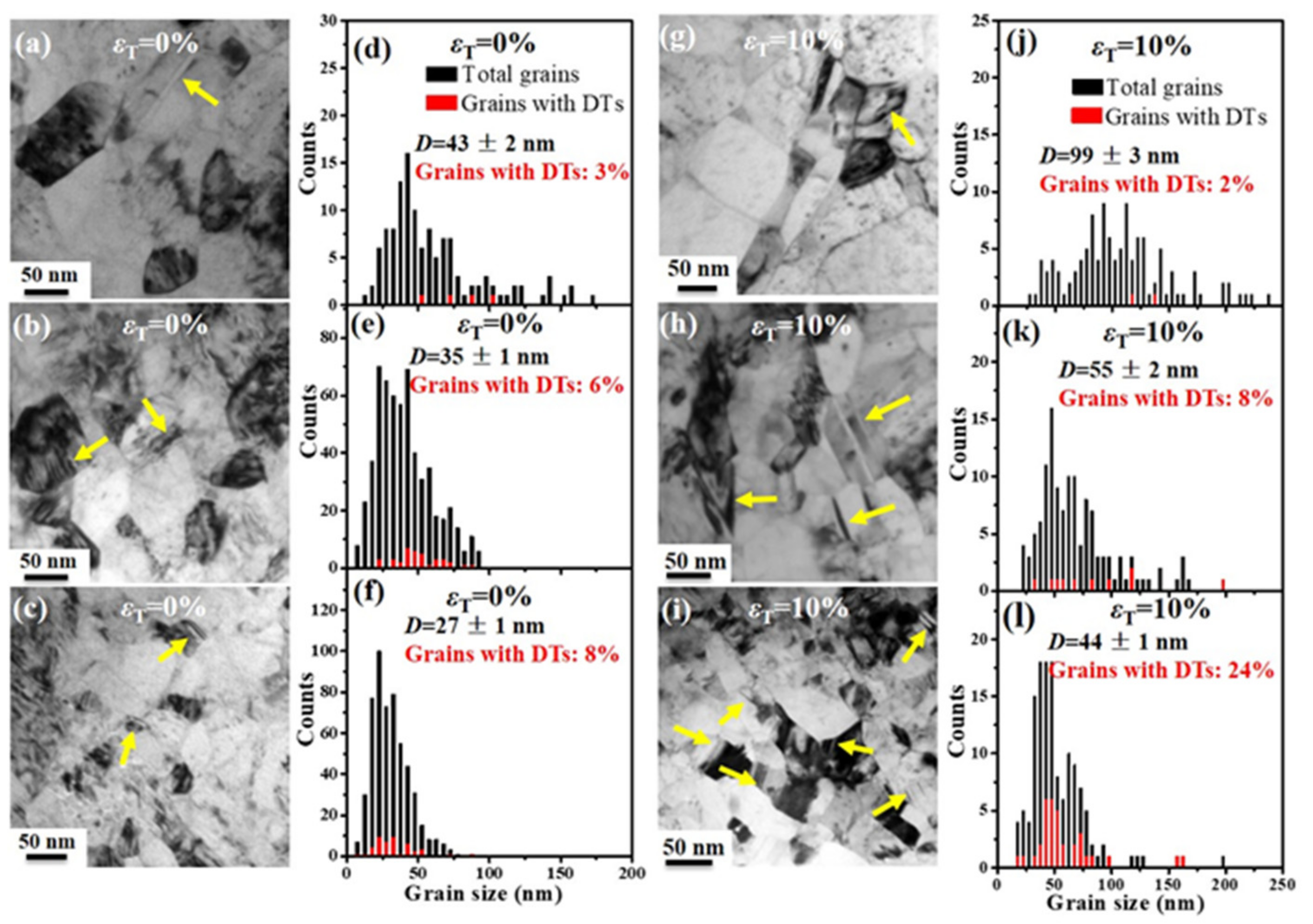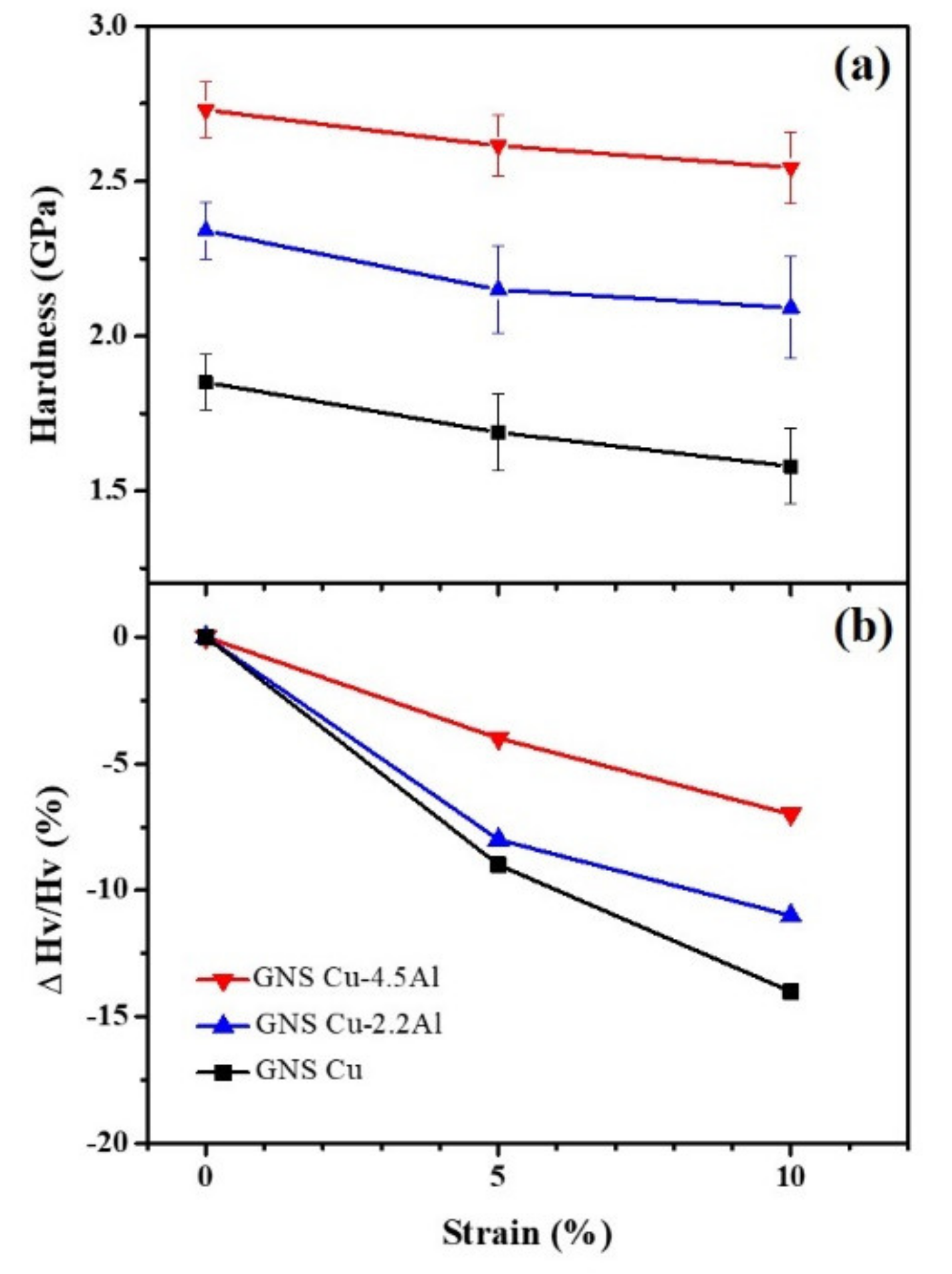Deformation Twinning Induced High Tensile Ductility of a Gradient Nanograined Cu-Based Alloy
Abstract
:1. Introduction
2. Materials and Methods
3. Results
3.1. Microstructures of Gradient Nanograined Cu and CuAl Alloys
3.2. Tensile Properties of Gradient Nanograined CuAl Alloys
3.2.1. Tensile Strength and Ductility
3.2.2. Work Hardening Rate
3.3. TEM Observations of Gradient Nanograined Cu and CuAl Alloys after Tension
3.4. SEM Observations of Surface Nanograins after Tension
4. Discussion
5. Conclusions
- The gradient nanograined Cu-4.5Al sample shows the high work hardening ability and uniform elongation of ~22% without any crack, due to the activation of deformation twinning in surface nanograins.
- Grain coarsening and mechanical twinning are insufficient for accommodating plastic deformation of surface nanograins in the Cu-2.5Al sample, resulting in the occurrence of surface cracks at a strain of ~10%.
- More deformation twinning and less grain coarsening suppress the softening of surface nanograins in the gradient nanograined Cu-4.5Al in comparison with the gradient nanograined Cu.
- This work suggests that deformation twinning is a potential deformation mode to achieve large tensile ductility of nanograined materials.
Author Contributions
Funding
Data Availability Statement
Conflicts of Interest
References
- Meyers, M.A.; Mishra, A.; Benson, D.J. Mechanical properties of nanocrystalline materials. Prog. Mater. Sci. 2006, 51, 427–556. [Google Scholar] [CrossRef]
- Koch, C.C. Optimization of strength and ductility in nanocrystalline and ultrafine grained metals. Scr. Mater. 2003, 49, 657–662. [Google Scholar] [CrossRef]
- Hughes, G.D.; Smith, S.D.; Pande, C.S.; Johnson, H.R.; Armstrong, R.W. Hall-Petch strengthening for the microhardness of twelve nanometer grain diameter electrodeposited nickel. Scr. Metall. 1986, 20, 93–97. [Google Scholar] [CrossRef]
- Rupert, T.J.; Gianola, D.S.; Gan, Y.; Hemker, K.J. Experimental Observations of Stress-Driven Grain Boundary Migration. Science 2009, 326, 1686–1690. [Google Scholar] [CrossRef] [PubMed] [Green Version]
- Chen, M.W.; Ma, E.; Hemker, K.J.; Sheng, H.W.; Wang, Y.M.; Cheng, X.M. Deformation twinning in nanocrystalline aluminum. Science 2003, 300, 1275–1277. [Google Scholar] [CrossRef] [PubMed] [Green Version]
- Wu, X.; Zhu, Y.T.; Chen, M.W.; Ma, E. Twinning and stacking fault formation during tensile deformation of nanocrystalline Ni. Scr. Mater. 2006, 54, 1685–1690. [Google Scholar] [CrossRef] [Green Version]
- Shan, Z.W.; Stach, E.A.; Wiezorek, J.M.K.; Knapp, J.A.; Follstaedt, D.M.; Mao, S.X. Grain boundary–mediated plasticity in nanocrystalline nickel. Science 2004, 305, 654–657. [Google Scholar] [CrossRef] [PubMed] [Green Version]
- Gianola, D.S.; Petegem, S.V.; Legros, M.; Brandstetter, S.; Swygenhoven, H.; Van Hemker, K.J. Stress-assisted discontinuous grain growth and its effect on the deformation behavior of nanocrystalline aluminum thin films. Acta Mater. 2006, 54, 2253–2263. [Google Scholar] [CrossRef]
- Hu, J.; Shi, Y.N.; Sauvage, X.; Sha, G.; Lu, K. Grain boundary stability governs hardening and softening in extremely fine nanograined metals. Science 2017, 355, 1292–1296. [Google Scholar] [CrossRef] [PubMed]
- Wang, Y.M.; Wang, K.; Pan, D.; Lu, K.; Hemker, K.J.; Ma, E. Microsample tensile testing of nanocrystalline copper. Scr. Mater. 2003, 48, 1581–1586. [Google Scholar] [CrossRef] [Green Version]
- Fang, T.H.; Li, W.L.; Tao, N.R.; Lu, K. Revealing extraordinary intrinsic tensile plasticity in gradient nano-grained copper. Science 2011, 331, 1587–1590. [Google Scholar] [CrossRef] [PubMed] [Green Version]
- Yang, M.; Pan, Y.; Yuan, F.; Zhu, Y.; Wu, X. Back stress strengthening and strain hardening in gradient structure. Mater. Res. Lett. 2016, 4, 145–151. [Google Scholar] [CrossRef]
- Wu, X.L.; Jiang, P.; Chen, L.; Yuan, F.P.; Zhu, Y.T. Extraordinary strain hardening by gradient structure. PNAS 2014, 111, 7197–7201. [Google Scholar] [CrossRef] [PubMed] [Green Version]
- Edalati, K.; Akama, D.; Nishio, A.; Lee, S.; Yonenaga, Y.; Cubero-Sesin, J.M.; Horita, Z. Influence of dislocation–solute atom interactions and stacking fault energy on grain size of single-phase alloys after severe plastic deformation using high-pressure torsion. Acta Mater. 2014, 69, 68–77. [Google Scholar] [CrossRef]
- Kirchheim, R. Reducing grain boundary, dislocation line and vacancy formation energies by solute segregation II. Experimental evidence and consequences. Acta Mater. 2007, 55, 5139–5148. [Google Scholar] [CrossRef]
- Wang, J.J.; Tao, N.R.; Lu, K. Revealing the deformation mechanisms of nanograins in gradient nanostructured Cu and CuAl alloys under tension. Acta Mater. 2019, 180, 231–242. [Google Scholar] [CrossRef]
- Li, W.L.; Tao, N.R.; Lu, K. Fabrication of a gradient nano-micro-structured surface layer on bulk copper by means of a surface mechanical grinding treatment. Scri. Mater. 2008, 59, 546–549. [Google Scholar] [CrossRef]
- Rösner, H.; Markmann, J.; Weissmüller, J. Deformation twinning in nanocrystalline Pd. Philos. Mag. Lett. 2006, 84, 321–334. [Google Scholar] [CrossRef]
- Brons, J.G.; Padilla, H.A.; Thompson, G.B.; Boyce, B.L. Cryogenic indentation-induced grain growth in nanotwinned copper. Scr. Mater. 2013, 68, 781–784. [Google Scholar] [CrossRef]




Publisher’s Note: MDPI stays neutral with regard to jurisdictional claims in published maps and institutional affiliations. |
© 2021 by the authors. Licensee MDPI, Basel, Switzerland. This article is an open access article distributed under the terms and conditions of the Creative Commons Attribution (CC BY) license (https://creativecommons.org/licenses/by/4.0/).
Share and Cite
Wang, J.; Tao, N. Deformation Twinning Induced High Tensile Ductility of a Gradient Nanograined Cu-Based Alloy. Nanomaterials 2021, 11, 2451. https://doi.org/10.3390/nano11092451
Wang J, Tao N. Deformation Twinning Induced High Tensile Ductility of a Gradient Nanograined Cu-Based Alloy. Nanomaterials. 2021; 11(9):2451. https://doi.org/10.3390/nano11092451
Chicago/Turabian StyleWang, Junjie, and Nairong Tao. 2021. "Deformation Twinning Induced High Tensile Ductility of a Gradient Nanograined Cu-Based Alloy" Nanomaterials 11, no. 9: 2451. https://doi.org/10.3390/nano11092451
APA StyleWang, J., & Tao, N. (2021). Deformation Twinning Induced High Tensile Ductility of a Gradient Nanograined Cu-Based Alloy. Nanomaterials, 11(9), 2451. https://doi.org/10.3390/nano11092451




